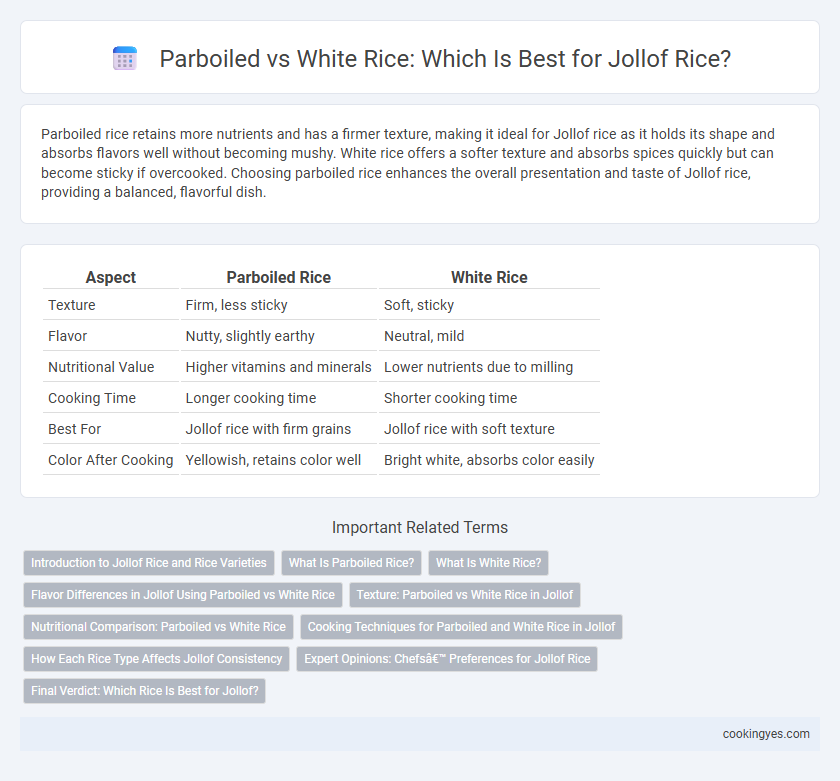Parboiled rice retains more nutrients and has a firmer texture, making it ideal for Jollof rice as it holds its shape and absorbs flavors well without becoming mushy. White rice offers a softer texture and absorbs spices quickly but can become sticky if overcooked. Choosing parboiled rice enhances the overall presentation and taste of Jollof rice, providing a balanced, flavorful dish.
Table of Comparison
| Aspect | Parboiled Rice | White Rice |
|---|---|---|
| Texture | Firm, less sticky | Soft, sticky |
| Flavor | Nutty, slightly earthy | Neutral, mild |
| Nutritional Value | Higher vitamins and minerals | Lower nutrients due to milling |
| Cooking Time | Longer cooking time | Shorter cooking time |
| Best For | Jollof rice with firm grains | Jollof rice with soft texture |
| Color After Cooking | Yellowish, retains color well | Bright white, absorbs color easily |
Introduction to Jollof Rice and Rice Varieties
Jollof rice, a beloved West African dish, traditionally features long-grain rice varieties that balance texture and flavor absorption. Parboiled rice retains more nutrients and has a firmer texture, making it ideal for the rich, spiced tomato sauce in Jollof, while white rice offers a softer, more delicate consistency. Choosing between parboiled and white rice impacts the dish's final texture and flavor intensity, influencing authenticity and regional preferences.
What Is Parboiled Rice?
Parboiled rice is partially boiled in the husk, which makes it firmer and less sticky compared to white rice, ideal for Jollof rice as it holds its shape during cooking. This process retains more nutrients like vitamin B and potassium, making parboiled rice a healthier option than regular white rice. Its slightly golden color and distinct texture enhance the flavor and presentation of traditional West African Jollof rice dishes.
What Is White Rice?
White rice is a polished grain stripped of its husk, bran, and germ, resulting in a softer texture and milder flavor ideal for Jollof rice. Compared to parboiled rice, white rice absorbs spices and tomato sauce more readily, enhancing the dish's rich, vibrant taste. Its quicker cooking time and fluffy consistency make it a popular choice for authentic West African Jollof recipes.
Flavor Differences in Jollof Using Parboiled vs White Rice
Parboiled rice imparts a nuttier, firmer texture to Jollof, allowing the grains to remain separate and absorb the rich tomato-based sauce without becoming mushy. White rice, with its softer and more delicate texture, tends to absorb flavors more quickly but can result in a creamier, less distinct grain separation. The choice between parboiled and white rice affects the overall mouthfeel and flavor intensity, with parboiled rice enhancing a more robust and textured Jollof experience.
Texture: Parboiled vs White Rice in Jollof
Parboiled rice offers a firmer, less sticky texture that holds up well in the rich, saucy consistency of Jollof rice, preventing mushiness during cooking. White rice provides a softer, fluffier texture that absorbs flavors quickly, giving Jollof a lighter, creamier appeal but may become mushy if overcooked. Selecting between parboiled and white rice depends on the desired mouthfeel and stability of the final dish's texture.
Nutritional Comparison: Parboiled vs White Rice
Parboiled rice retains more nutrients than white rice due to its processing method, which preserves higher levels of vitamins B1, B3, and B6 along with minerals like iron and magnesium. White rice undergoes more refining, resulting in reduced fiber content and lower amounts of essential nutrients compared to parboiled rice. For Jollof rice, choosing parboiled rice can enhance the dish's nutritional profile by providing increased energy, better digestion, and improved metabolism support.
Cooking Techniques for Parboiled and White Rice in Jollof
Parboiled rice requires longer soaking and precise water absorption control to achieve firm, separate grains ideal for Jollof, while white rice cooks faster but is more prone to sticking and becoming mushy. Parboiled rice's partial steaming process ensures better nutrient retention and a firmer texture that holds up during the simmering stage with tomato sauce. White rice demands careful timing and gentle stirring to prevent clumping, making cooking technique critical for achieving the perfect consistency in Jollof rice.
How Each Rice Type Affects Jollof Consistency
Parboiled rice retains more starch during processing, resulting in a firmer, less sticky Jollof consistency that holds its shape well and absorbs flavors without becoming mushy. White rice releases more starch when cooked, creating a softer, creamier texture that can lead to a stickier Jollof with a richer mouthfeel but less defined grain separation. Choosing parboiled rice ensures a drier, fluffier Jollof, while white rice yields a moist, cohesive dish favored for its ease in blending spices and sauce.
Expert Opinions: Chefs’ Preferences for Jollof Rice
Chefs specializing in Jollof rice often prefer parboiled rice due to its firmer texture and resistance to becoming mushy during the long cooking process. Expert culinary opinions highlight that parboiled rice better absorbs the rich tomato sauce and spices integral to authentic Jollof flavor without breaking down. While white rice remains common, professionals emphasize parboiled rice's ability to enhance the dish's overall consistency and taste, making it a favored choice among seasoned Jollof chefs.
Final Verdict: Which Rice Is Best for Jollof?
Parboiled rice is preferred for Jollof due to its firm texture and resistance to overcooking, which helps maintain the dish's signature fluffy consistency and separate grains. White rice, while softer and quicker to cook, tends to absorb more sauce and can become mushy, potentially compromising the ideal Jollof texture. For authentic Jollof rice, parboiled varieties like long-grain parboiled rice deliver superior results in flavor retention and structural integrity.
Parboiled vs White Rice for Jollof Infographic

 cookingyes.com
cookingyes.com